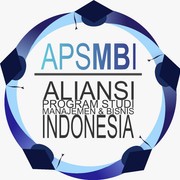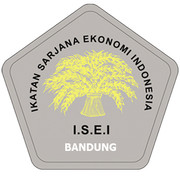Adopsi Literasi Fintech untuk E-Money di Kalangan Generasi Z
Abstract
The purpose of this study was to determine and analyze the effect of fintech literacy on actual usage of electronic money in Generation Z, as well as to determine and analyze the influence of perceived ease of use, perceived usefulness, and personal innovativeness on actual usage of electronic money in Generation Z. The method used in this study is a survey method with a verification approach. Where data is collected from a sample of 100 respondents through a questionnaire distributed through Google Form. Hypothesis testing is done using SEM Analysis with the help of SmartPLS 3.0 software. The results show that fintech literacy has a positive and significant effect on actual usage of electronic money. Perceived ease of use and perceived usefulness have no significant effect on actual usage of electronic money, while personal innovativeness has a positive and significant effect on actual usage of electronic money. Personal innovativeness is also known to be a factor that has the greatest influence on actual usage of electronic money in Generation Z. This research has implications for the development of management science, especially to see the effect of fintech literacy on actual usage of electronic money that can be used by the financial services sector as a basis for decision making.
Keywords
Full Text:
PdfReferences
Aaron, M., Rivadeneyra, F., & Sohal, S. (2017). Fintech: Is this time different? A framework for assessing risks and opportunities for Central Banks (No. 2017-10). Bank of Canada Staff Discussion Paper.
Alam, S. S., Omar, N. A., Ariffin, A. M., & Hashim, N. M. H. N. (2018). Integrating TPB, TAM and DOI theories: an empirical evidence for the adoption of mobile banking among customers in klang valley, Malaysia. International Journal of Business and Management Science, 8(2), 385-403.
Alghatrifi, I., & Khalid, H. (2019, December). A systematic review of UTAUT and UTAUT2 as a baseline framework of information system research in adopting new technology: a case study of IPV6 adoption. In 2019 6th International Conference on Research and Innovation in Information Systems (ICRIIS) (pp. 1-6). IEEE.
Alshurideh, M., Al Kurdi, B., & Salloum, S. A. (2019, October). Examining the main mobile learning system drivers’ effects: A mix empirical examination of both the Expectation-Confirmation Model (ECM) and the Technology Acceptance Model (TAM). In International Conference on Advanced Intelligent Systems and Informatics (pp. 406-417). Springer, Cham.
Bank Indonesia; Peredaran Uang Elektronik. 2021. Jumlah Uang Elektronik Beredar.
Bhagat, R., & Sambargi, S. (2019). Evaluation of personal innovativeness and perceived expertise on digital marketing adoption by women entrepreneurs of micro and small enterprises. International Journal of Research and Analytical Reviews (IJRAR), 6(1), 338-351.
Bhatt, S., & Shiva, A. (2020). Empirical Examination of the Adoption of Zoom Software During Covid-19 Pandemic: Zoom Tam. Journal of Content, Community & Communication, 12(6).
Brandon-Jones, A., & Kauppi, K. (2018). Examining the antecedents of the technology acceptance model within e-procurement. International Journal of Operations & Production Management.
Brusch, I., & Rappel, N. (2020). Exploring the acceptance of instant shopping–An empirical analysis of the determinants of user intention. Journal of Retailing and Consumer Services, 54, 101936.
Chaurasia, S. S., Verma, S., & Singh, V. (2019). Exploring the intention to use M-payment in India: Role of extrinsic motivation, intrinsic motivation and perceived demonetization regulation. Transforming Government: People, Process and Policy.
Chen, Y. H. H., & Corkindale, D. (2008). Towards an understanding of the behavioral intention to use online news services: An exploratory study. Internet Research.
Davis, F. D. (1989). Perceived usefulness, perceived ease of use, and user acceptance of information technology. MIS quarterly, 319-340.
Francis, T., & Hoefel, F. (2018). True Gen’: Generation Z and its implications for companies. McKinsey & Company, 12.
Gabsir, M. (2020). Pengaruh Literasi Keuangan dan Literasi Teknologi Terhadap Adopsi Uang Elektronik Pada Mahasiswa Fakultas Bisnis dan Ekonomika Universitas Atma Jaya Yogyakarta (Doctoral dissertation, Universitas Atma Jaya Yogyakarta).
Ghozali, I., & Latan, H. (2015). Partial Least Squares, konsep, teknik dan aplikasi menggunakan program Smartpls 3.0 un-tuk penelitian empiris. Semarang: Badan Penerbit UNDIP.
Helaluddin, H. (2019). Peningkatan kemampuan literasi teknologi dalam upaya mengembangkan inovasi pendidikan di perguruan tinggi. PENDAIS, 1(01), 44-55.
HSB, M. S., & Dewi, A. S. (2020). Digitalisasi Perbankan: Adopsi Layanan Fintech oleh Usia Produktif Indonesia (Studi Pada Masyarakat Kota Bandung, Jawa Barat). Jurnal Mitra Manajemen, 4(1), 86-101.
Hua, X., Huang, Y., & Zheng, Y. (2019). Current practices, new insights, and emerging trends of financial technologies. Industrial Management & Data Systems.
Hubert, M., Blut, M., Brock, C., Zhang, R. W., Koch, V., & Riedl, R. (2019). The influence of acceptance and adoption drivers on smart home usage. European Journal of Marketing.
Hussain, M., Mollik, A. T., Johns, R., & Rahman, M. S. (2019). M-payment adoption for bottom of pyramid segment: an empirical investigation. International Journal of Bank Marketing.
Karimi, S., & Liu, Y. L. (2020). The differential impact of “mood” on consumers’ decisions, a case of mobile payment adoption. Computers in Human Behavior, 102, 132-143.
Kurniawan, R. (2019). Examination of the factors contributing to financial technology adoption in Indonesia using technology acceptance model: case study of peer to peer lending service platform. In 2019 International Conference on Information Management and Technology (ICIMTech) (Vol. 1, pp. 432-437). IEEE.
Lai, P. C. (2017). Security as an extension to TAM model: Consumers’ intention to use a single platform E-Payment. Asia-Pacific Journal of Management Research and Innovation, 13(3-4), 110-119.
Li, L., Wang, Z., Li, Y., & Liao, A. (2021). Impacts of consumer innovativeness on the intention to purchase sustainable products. Sustainable Production and Consumption, 27, 774-786.
Li, Y., Li, X., Zhang, Z., Zhang, G., & Gong, M. (2020). Understanding Consumers Online Furniture Purchase Behavior: An Updated UTAUT Perspective. Journal of Forest Economics, 35(4), 267-303.
Naranjo-Zolotov, M., Oliveira, T., & Casteleyn, S. (2018). Citizens’ intention to use and recommend e-participation: Drawing upon UTAUT and citizen empowerment. Information Technology & People.
Ogbeide, O. A. (2015). Consumer behaviour in product acquisition: Literature review. The Marketing Review, 15(3), 335-360.
Orè, S. B., & Rodriguez, L. L. (2017, August). TAM: A reference model for mobile cash adoption. In Proceedings of the 7th International Conference on Information Communication and Management (pp. 148-152).
Phonthanukitithaworn, C., Sellitto, C., & Fong, M. W. (2016). An investigation of mobile payment (m-payment) services in Thailand. Asia-Pacific Journal of Business Administration.
Pilav-Velic, A., Selimovic, J., & Jahic, H. (2020). Personal Innovativeness and Employability: How Personal Traits Affect Employer Attractiveness. In Eurasian Business Perspectives (pp. 23-32). Springer, Cham.
Poll, H. (2020). Harris poll COVID-19 survey, wave 9. Harris Poll, 20.
Ramadanti, H., & Nawir, J. (2021). ANALISIS PERILAKU KEUANGAN GENERASI Z PADA CASHLESS SOCIETY: Literasi Keuangan, Gaya Hidup, Perilaku Keuangan, Cashless Society. Jurnal Visionida, 7(2), 96-109.
Raza, S. A., Shah, N., & Ali, M. (2019). Acceptance of mobile banking in Islamic banks: evidence from modified UTAUT model. Journal of Islamic marketing.
Rogers, E. M., Singhal, A., & Quinlan, M. M. (2014). Diffusion of innovations (pp. 432-448). Routledge.
Ronaghi, M. H., & Forouharfar, A. (2020). A contextualized study of the usage of the Internet of things (IoTs) in smart farming in a typical Middle Eastern country within the context of Unified Theory of Acceptance and Use of Technology model (UTAUT). Technology in Society, 63, 101415.
Sarmah, R., Dhiman, N., & Kanojia, H. (2021). Understanding intentions and actual use of mobile wallets by millennial: an extended TAM model perspective. Journal of Indian Business Research.
Semerikova, E. (2019). Payment instruments choice of Russian consumers: reasons and pain points. Journal of Enterprising Communities: People and Places in the Global Economy.
Shaikh, I. M., Qureshi, M. A., Noordin, K., Shaikh, J. M., Khan, A., & Shahbaz, M. S. (2020). Acceptance of Islamic financial technology (FinTech) banking services by Malaysian users: an extension of technology acceptance model. foresight.
Sim, J. J., Chia, Z. Y., Chin, Y. L., Lee, M. Q., Chiam, V. T. S., Wong, K. L., ... & Yeap, K. H. (2018, November). Trust in vendor and perceived effectiveness of E-commerce institutional mechanisms in M-commerce adoption: A revised UTAUT model. In 2018 8th IEEE international conference on control system, computing and engineering (ICCSCE) (pp. 10-15). IEEE.
Soomro, Y. A. (2019). Understanding the adoption of sadad e-payments: UTAUT combined with religiosity as moderator. International Journal of E-Business Research (IJEBR), 15(1), 55-74
Spires, H., & Bartlett, M. (2012). Digital literacies and learning: Designing a path forward. Friday Institute White Paper Series, 5.
Yaru, W. (2020). An empirical study on the users' continuous intention of imported cross-border e-commerce platforms based on TAM and perceived risk theory. In Proceedings of the 2020 3rd International Conference on Big Data Technologies (pp. 237-241).
Yeo, J. H., & Fisher, P. J. (2017). Mobile financial technology and consumers’ financial capability in the United States. Journal of Education & Social Policy, 7(1), 80-93.
DOI: https://doi.org/10.17509/image.2023.001
Refbacks
- There are currently no refbacks.
Copyright (c) 2023 Tia Yuliawati, Heny Hendrayati, Cici Cintyawati, Chairul Furqon
Image : Jurnal Riset Manajemen is licensed under a Creative Commons Attribution-ShareAlike 4.0 International License
View My Stats



